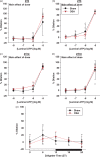The rat cerebral vasculature exhibits time-of-day-dependent oscillations in circadian clock genes and vascular function that are attenuated following obstructive sleep apnea
- PMID: 27798273
- PMCID: PMC5536790
- DOI: 10.1177/0271678X16675879
The rat cerebral vasculature exhibits time-of-day-dependent oscillations in circadian clock genes and vascular function that are attenuated following obstructive sleep apnea
Abstract
Circadian clock components oscillate in cells of the cardiovascular system. Disruption of these oscillations has been observed in cardiovascular diseases. We hypothesized that obstructive sleep apnea, which is associated with cerebrovascular diseases, disrupts the cerebrovascular circadian clock and rhythms in vascular function. Apneas were produced in rats during sleep. Following two weeks of sham or obstructive sleep apnea, cerebral arteries were isolated over 24 h for mRNA and functional analysis. mRNA expression of clock genes exhibited 24-h rhythms in cerebral arteries of sham rats (p < 0.05). Interestingly, peak expression of clock genes was significantly lower following obstructive sleep apnea (p < 0.05). Obstructive sleep apnea did not alter clock genes in the heart, or rhythms in locomotor activity. Isolated posterior cerebral arteries from sham rats exhibited a diurnal rhythm in sensitivity to luminally applied ATP, being most responsive at the beginning of the active phase (p < 0.05). This rhythm was absent in arteries from obstructive sleep apnea rats (p < 0.05). Rhythms in ATP sensitivity in sham vessels were absent, and not different from obstructive sleep apnea, following treatment with L-NAME and indomethacin. We conclude that cerebral arteries possess a functional circadian clock and exhibit a diurnal rhythm in vasoreactivity to ATP. Obstructive sleep apnea attenuates these rhythms in cerebral arteries, potentially contributing to obstructive sleep apnea-associated cerebrovascular disease.
Keywords: Cerebrovascular circulation; circadian clock; diurnal rhythm; obstructive sleep apnea; vasodilation.
Figures







References
-
- Edery I. Circadian rhythms in a nutshell. Physiol Genom 2000; 3: 59–74. - PubMed
-
- Wilsbacher LD, Takahashi JS. Circadian rhythms: Molecular basis of the clock. Curr Opin Genet Dev 1998; 8: 595–602. - PubMed
-
- Dunlap JC. Molecular bases for circadian clocks. Cell 1999; 96: 271–290. - PubMed
-
- Young ME. The circadian clock within the heart: Potential influence on myocardial gene expression, metabolism, and function. Am J Physiol Heart Circ Physiol 2006; 290: H1–H16. - PubMed
-
- Berson DM, Dunn FA, Takao M. Phototransduction by retinal ganglion cells that set the circadian clock. Science 2002; 295: 1070–1073. - PubMed
MeSH terms
Substances
Grants and funding
LinkOut - more resources
Full Text Sources
Other Literature Sources

